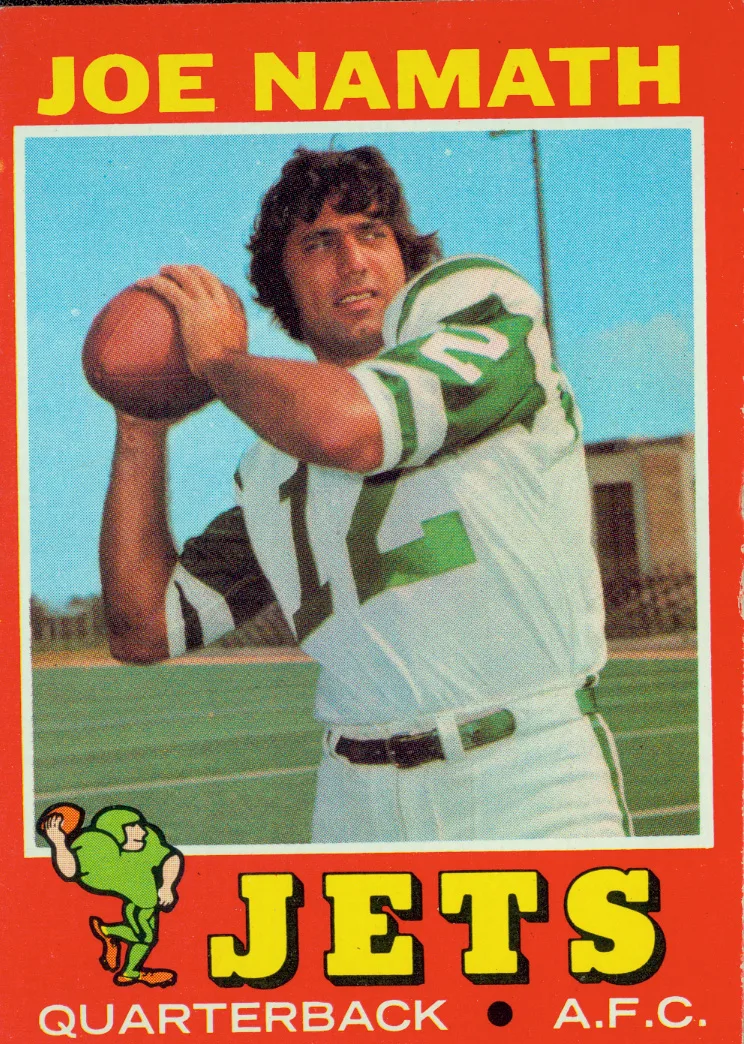
Topps Football Sets Tone for the 1970s
Continuing our series of the best Topps football designs by decade after the Nifty Fifties and the Swinging ‘60s, let’s pick the most iconic set of the Groovy ‘70s.
In 1971, Topps wanted to honor the merger between the AFL and NFL by giving teams in the new AFC and NFC different color backgrounds/borders. It was red for the AFC and blue for the NFC. The NFL All-Stars were ingeniously appointed with red and blue borders to show they were beyond mere league classification.
One of the challenges for dogged collectors (or features if you enjoy searching far and wide for highly graded cards) is that the solid, dark borders are very condition-sensitive. Any minor corner wear or edge chipping is glaringly apparent.
Bright, Fun, and Kid Friendly
On the card front, every position was depicted in a bright cartoon under the player’s photo. So, running backs, quarterbacks, punters, and defenders were all given an animated doppelgänger. The cartoon was placed above the position designation and next to the team name. The team’s conference was also identified on the card front, a new feature for all teams. This was especially important for teams like the Colts, Steelers, and Browns, who were moved out of the old-NFL-dominated NFC into the AFL-heavy AFC.
The player’s name is more prominent on the card face than in any football design. Overall, it’s fun, bright, kid-friendly, very clean, and non-busy.

The back content is probably the most comprehensive in Topps history for any sports set. The player’s biographical info, including height and weight, and a personal factoid about the player with a related cartoon take up the top quarter of the back. This typically leaves ample space for player records and highlights, including any team records they hold. For example, the Gale Sayers back copy is 118 words. Joe Namath’s is 105 words. This player copy is more like the player descriptions you’d see in a team media guide than what you typically get on the back of a card.
The player’s yearly and career stats are detailed. But an extensive playing career didn’t significantly alter the bio space. Johnny Unitas has 15 years of stats on his card but STILL a 73-word bio that fully documents his greatness and impact on the league, including how he starred in “The Greatest Game Ever Played” (the 1958 title game against the Giants). None of the biographical information seems rushed. It’s written in a manner that assumes that young fans will really spend time with these cards and learn about the players and game.

Hall of Famers and Rookie Galore
We’ve touched on just a few of the Hall of Famers that make this set so collectible. There are 55 players on the checklist now enshrined in Canton, the most recent being Chuck Howley in 2023. That’s 21% of the 263-card set. The set contains 87 rookie cards, with overlapping Hall of Famers including Mean Joe Greene, Terry Bradshaw, Ken Houston, and Willie Lanier. More than half the set is Hall of Famers or rookies.
Given the difficulty of getting top grades, key cards in top condition are very valuable. According to GemRate.com, there are practically no PSA 10s, just 0.00114%. Even PSA 7 (Near Mint) is a tough grade, with only 15-20% of star submissions reaching that level.
According to Card Ladder, the Bradshaw rookie sold for $26,316 in PSA 9 condition this year. A centered PSA 7 (near mint) costs about $800. Recently, a complete PSA 8 condition (NM-MT) set sold for $28,060.
While other sets in the decade, especially the 1972 set, rate about as high according to the Trading Card Database, 1971 Topps gets the edge for collectability and the thrill of finding rare ones that remain in top condition. Other than the 1962 Topps Football “Black Bordered Beauties,” it’s the toughest football set to find in high grade that Topps ever produced.